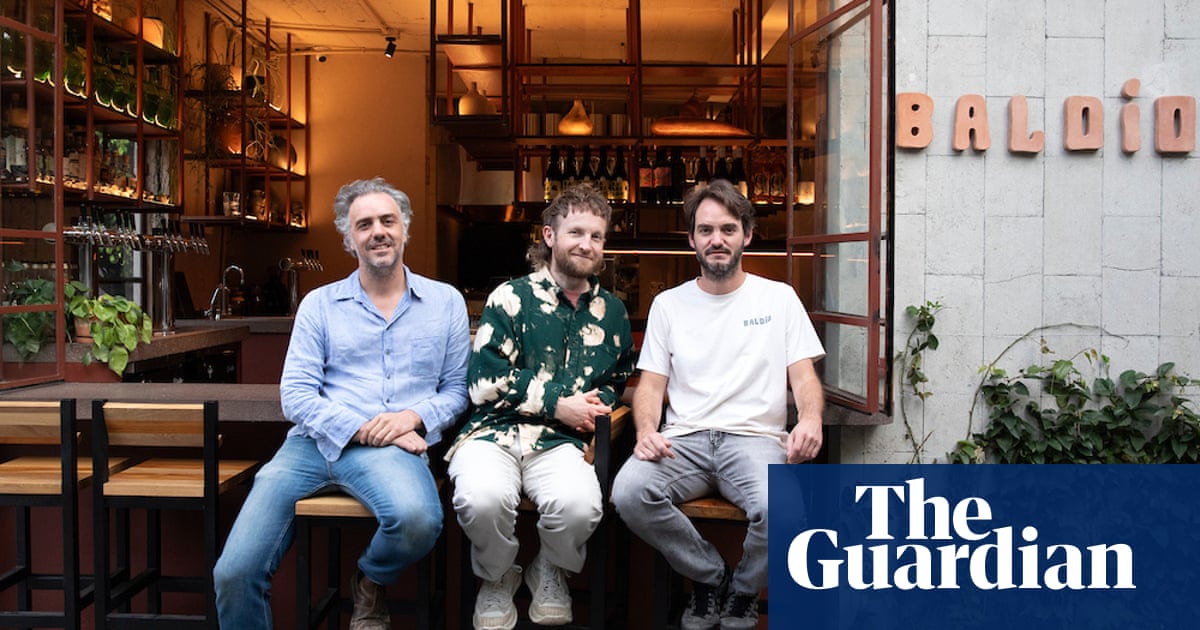Hunched over the pass in the open restaurant kitchen, a team of chefs are dusting ceviche with a powder made from lime skins that would, in most cases, have been thrown away. TheMexicoCity restaurant where they work looks like most restaurant kitchens but it lacks one key element: there is no bin.
Baldío was co-founded by brothers Lucio and Pablo Usobiaga and chef Doug McMaster, best known for his groundbreaking zero-waste spot Silo London. “In my eyes, bins are coffins for things that have been badly designed,” says McMaster. “If there was a trophy for negligence, it would be bin-shaped.”
The food, which recently earned a Michelin green star, is creative but still quintessentially Mexican: squash tostada with guaca-broccoli, maguey flower, maguey worm, chinampa flower, or grassfed pork from Veracruz with tamarind mole, served with chinampa greens and house-made kimchi. Significant planning is needed from sourcing to preparation, and the founders are also behind Arca Tierra, a regenerative agriculture project that includes a network of 50 farmers in central Mexico as well as the organisation’s own farm in the pre-Aztec canal system at Xochimilco, an ancient neighbourhood in the south of Mexico City.
“Restaurants can have a big environmental impact but they also have a big reach,” says Lucio Usobiaga. “We want Baldío to be a model that shows it’s possible to be both zero waste and to rely on farmers rather than supermarkets.”
Although the food is finished off in the restaurant’s open kitchen, most preparation happens at La Baldega, a workshop where the team operates a fermentation programme that helps preserve ingredients as well as upcycle byproducts such as peel and gristle. This includes pre-Hispanic Mexican drinks such as tepache and pulque, as well as koji fermentation – popular in Japan and China for thousands of years – to transform fish guts into sauce.
Globally, one-fifth of food is lost or wasted, according to the UN, equivalent to 1bn meals a day, at a time when one in every nine people is malnourished. When food decomposes in landfill it releases methane, which has 25-times higher global warming potential than carbon dioxide.
Silo, when it opened in 2014, became the first restaurant in the world not to have a bin, raising the bar on what zero waste means. Less than 1% of food is composted and no single-use materials are used. A dedicated pottery transforms glass into porcelain that is used for tableware, light fixtures and tiles.
Baldío is part of a new wave of restaurants that are moving beyond vague claims of sustainability to embrace a regenerative ethos. In Lisbon,SEM, from the Silo alumni Lara Santo and George McLeod, serves invasive freshwater fish such as the zander, which was introduced to Portugal in the 1980s for sport.Flores, a family-run restaurant in Nijmegen, the Netherlands, dries offal in koji before shaving it over meat dishes. Helsinki’sNolla(meaning “zero” in Finnish) gives compost to its suppliers and guests – a doggy bag with a difference.
Baldío goes one step further through its symbiotic relationship with Xochimilco, the last remnant of the network of blue-green waterways that dazzled Spanish invaders when they arrived 500 years ago. The Unesco heritage site is a key stopover for migratory birds and the only place where axolotls still live in the wild.
Although the unique ecosystem is severely threatened by urban sprawl, many Indigenous residents still farmchinampas(a pre-Aztec technique consisting of islands formed from willow trees, lilies and mud), gliding through the blue-green canals on wobbly canoes laden with lettuce, radish andverdolagas(Mexican parsley).
“In agriculture, how you go about production really determines how much carbon you emit,” says Melanie Kolb, a researcher at the National Autonomous University of Mexico.
As well as buying from five local families, Arca Tierra farms 18chinampasusing a three-row agroforestry system. The farming team led by Sonia Tapia Garcés combines ancestral techniques such aschapines– rich sediment cut into squares used for germinating seeds – with compost from Baldío’s kitchen and a hi-tech wood shedder that allows them to create mulch, which contributes to the soil’s potential for carbon sequestration.
Sign up toDown to Earth
The planet's most important stories. Get all the week's environment news - the good, the bad and the essential
after newsletter promotion
The result is a crop that is irrigated with bio-filtered canal water and can be harvested 365 days a year without depleting the soil’s nutrients. It is enough to supply 50% of Baldío’s needs. The restaurant’s chefs, who visit every Monday to plan that week’s menus, have a continuing dialogue with the growers and often help with harvesting.
Ingredients are carried by boat to downtown Xochimilco and driven 8km to La Baldega. Reducing distance travelled and the need for refrigeration on longer journeys results in a fraction of the carbon emissions associated with typical restaurant supply chains.
For 74-year-old Noy Coquis Saldedo, who rents land to Arca Tierra, the project offers an opportunity to preserve his identity at a time when just 2.5% of thechinampasare still used for traditional agriculture. “It’s very sad that young people don’t want to farm any more,” he says. “But now we are delivering food to the great city like my ancestors did.”
A pod of young pelicans surf a warm gust between the verdant banks, practising for the journey they will soon make to California. For Lucio Usobiaga, closing the loop between thechinampasand Baldío could be a blueprint for the future. “Ultimately, I hope the project shows people that a more just and better food system is possible.”
And the food? When the Guardian tasted it, it was delicious: flame-licked, spiked with salsas and texturally balanced, it is distinctly Mexican – yet also something entirely its own.
